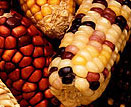Prakash
Interviews
AgBioWorld
Articles
Other
Articles
Biotech
and Religion
Media Contacts
Press
Releases
Special
Topics
Spanish
Articles
|
 |
 |
 |
MEXICAN MAIZE NOT UNDER THREAT
Biologically diverse gene flow is natural and expected, not "contamination"
Contact: C.S. Prakash, 334-633-1511, prakash@agbioworld.org
Tuskegee, AL March 1, 2002 - The AgBioWorld Foundation announced today
that nearly one hundred prominent scientists have signed a petition calling
for greater scrutiny of a report claiming that genes from genetically
modified corn have spread into corn landraces in southern Mexico (see
http://www.agbioworld.org/jointstatement.html).
The original research, conducted by University of California at Berkeley
ecologists and published in the journal Nature, used sophisticated techniques
that are highly prone to error. Three groups of university-based scientists,
working independently, have examined the research data and found it to
be erroneous. Each group has submitted formal letters to Nature questioning
the study's validity. In addition, the editors of the journal Transgenic
Research examined the data and have determined it to be "fundamentally
flawed."
Despite the inadequacies and misrepresentations of this particular study,
gene flow from biotechnology-improved corn, as with all corn, is most
likely occurring at some frequency and will certainly be demonstrated
and accurately characterized through further studies. However, if indeed
gene flow is demonstrated, there is no reason to believe that it will
threaten the diversity or vitality of Mexican landraces, and labeling
gene flow as "contamination," as activists have done, is a misnomer
and is a deliberate attempt to provide an emotional tone to a benign natural
phenomenon.
Mexican landraces should not be confused with teosinte, the wild plant
from which maize is thought to have been originally developed by humans
over millennia. Far from being static, non-changing genetic entities,
landraces are ever-changing due to human intervention -- in fact, they
only exist because of human efforts. "Just as wild Mexican wolves
are different from Chihuahuas, which have been bred for centuries, teosinte
is vastly different from all cultivated maize, including landraces,"
said C.S. Prakash, Tuskegee University plant genetics professor and president
of the AgBioWorld Foundation.
Mexican landraces of maize have always outcrossed with modern maize varieties.
But far from being a threat to biodiversity, as has been claimed by activists
and the flawed-study authors, it instead promotes diversity by allowing
for the development of additional new varieties. Furthermore, there is
no reason to believe that transgenic hybrids would affect biodiversity
more than any other hybrid. "If anything, gene flow would aid diversity
by increasing variation," said Prakash.
Despite the fanfare and media buzz the flawed-study authors have created
and encouraged, gene flow between biotechnology-improved maize varieties
was publicly anticipated long ago by plant breeders and scientists and
is no cause for alarm. In 1995, the International Maize and Wheat Improvement
Center (CIMMYT) held a workshop on "Gene Flow Among Maize Landraces,
Improved Maize Varieties, and Teosinte: Implications for Transgenic Maize,"
and CIMMYT scientists have transparently presented their findings, writing
journal articles and giving presentations on related topics.
It is regrettable that Nature, the same publication that released the
Monarch butterfly study - which activists use to this day to inaccurately
discredit GM corn -- decided to publish these new claims. As with the
Monarch report, which extensive review has demonstrated greatly exaggerated
any risks to Monarchs, respected scientists now have shown significant
flaws and exaggerated claims of harm with the Chapela and Quist research.
Unfortunately, this latest activist-fueled scare campaign may have far
worse consequences, as Mexican farmers will be the ones who ultimately
suffer if denied the same technology that American farmers have successfully
used for years.
|

